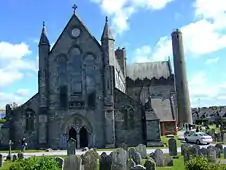William de Karlell
William de Karlell (died 1383) was an English-born judge, administrator and cleric in fourteenth-century Ireland. He held numerous benefices including Archdeacon of Meath and Rector of Youghal, and sat in the Irish House of Commons. After many years as a Baron of the Court of Exchequer (Ireland) served briefly as Chief Baron of the Irish Exchequer. He is buried in St Canice's Cathedral, Kilkenny.[1]
Background
He took his family name from his birthplace, Carlisle, Cumberland.[2] John de Karlell (died 1393), Chancellor of St Patrick's Cathedral, Dublin, was his brother; John also became a Baron of the Exchequer.[3] They were apparently of fairly humble origins, as suggested by the later complaint that William was not a fit person to arrest a member of the aristocratic Wellesley family. William himself seems to have been rather sensitive about his social origins.
Career
He came to Ireland as part of the entourage of Lionel of Antwerp, the Lord Lieutenant of Ireland, in 1361, and was made Baron of the Court of Exchequer (Ireland) in 1367.[4] He became a prebendary of St Patrick's Cathedral the same year and later acquired numerous other prebendaries, including Ossory. His main residence was in Kilkenny; he was a burgess of the town and died there. In 1374 he and his brother John were summoned to the Parliament of Ireland in Dublin as two of the King's counsel.[5] In 1383 the King appointed him Queen's Attorney;[6] soon after he was made Chief Baron, but he died within a few months of his promotion.
Duties
James Graves remarks that since the Catholic Church in the fourteenth century was the only source of highly educated men, clerics like the Karlell brothers were as much civil servants as priests.[7] William's duties went far beyond his judicial tasks: he audited accounts, supervised sheriffs elections, inquired into the condition of Crown lands, and into the existence of buried treasure. His duties involved much labour and money, and in 1374 he received £20 for, among other expenses, the theft of his horse.[8] This was probably in connection with the lengthy inquiry into the Crown's property rights in County Wexford and County Waterford, with particular regard to the question of treasure trove, which was conducted by de Karlell and two colleagues, John Keppock and Walter Cotterell.[9]
Character
From the limited evidence available to us about his personality, he seems to have been a proud man with a keen sense of his own dignity. In 1372 Sir William Wellesley, ancestor of the 1st Duke of Wellington, was arrested for disobeying a summons to appear before Karlell, and in the following year one Richard Bateman was found guilty of contempt of court for saying that Karlell was not fit to arrest one of Wellesley's rank, presumably due to his lower social standing.[10]
Tomb
James Graves in his history of St. Canice's Cathedral, published in 1857, described William's tomb as a coffin-shaped slab, six feet by two, elevated about two feet from the floor of the cathedral, and completely unadorned except for an inscription giving William's name and clerical offices.[11] His brother John was also buried in St Canice's, but his tomb was largely destroyed in the seventeenth century.

References
- Ball, F. Elrington The Judges in Ireland 1221-1921 John Murray London 1926 Vol. 1 pp. 85-6
- Ball p.85
- Ball p.167
- Ball p.86
- Graves, James The History, Architecture and Antiquities of the Cathedral Church of St Canice Kilkenny Hodges Smith Dublin 1857 p 154
- Graves p. 154
- Graves p.152
- Ball p.34
- Smyth, Constantine Joseph Chronicle of the Law Officers of Ireland London 1839 p.183
- Graves pp.152-3
- Graves p.151
